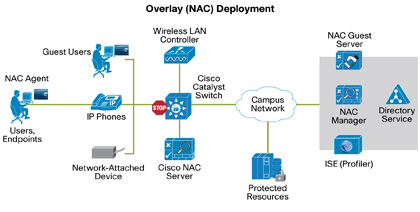Cisco Bridge-group Virtual Interface (BVI)
A BVI (Bridge Group Virtual Interface) is a routed interface that represents a set of Ethernet interfaces that gets bridged. By using a Bridge group Virtual Interface, you can convert multiple Router Ethernet WAN interfaces as members of a common Ethernet broadcast domain
This configuration allows bridging IP between two Ethernet interfaces, and routing IP from bridgedinterfaces using a Bridge Virtual Interface (BVI). By using Integrated Routing and Bridging (IRB)technique, a Cisco router can be turned into a L3 switch. Ip addresses can be assigned on Bridge-Group Virtual Interfaces (BVIs), similar to VLAN interfaces as in L3 switches. A BVI is a virtual routed interface that has all network layer attributes, eg: a network address can be assigned to it and does not support bridging.
Bridge groups are defined by a unique number and are used for router bridging configuration. Network traffic is bridged between all interfaces that belong to the same bridge group.
Step by Step Bridge Group Virtual Interface (BVI) Configuration
Integrated Routing and Bridging configuration on Router1:
Router (config)#int fa0/0
Router (config-if)#bridge-group 1
Router (config-if)#no shut
Router(config-if)#exit
Router (config)#
Router (config-if)#int fa1/0
Router(config-if)#bridge-group 1
Router (config-if)#no shut
Router(config-if)#exit
Router(config)#
Create Bridge Group Virtual Interface (BVI) and configure the IP and Routing credentials.
Router1(config)#bridge irb
Router (config)#int bvi1
Router(config-if)#ip add 192.168.2.1 255.255.255.0
Router(config-if)#exit
Router(config)#bridge 1 protocol ieee
Router (config)#bridge 1 route ip
Router(config)#
Note: The bridge 1 protocol ieee global configuration command removes bridge-group 1 spanning-disabled interface subcommand on Fa0/0 and Fa1/0 and hence enables STP on bridged interfaces.
Find Bridge Group Virtual Interface (BVI) show command outputs
Router#sh spanning-tree brief
Bridge group 1
Spanning tree enabled protocol ieee
Root ID Priority 32768
Address cc01.01e0.0000
This bridge is the root
Hello Time 2 sec Max Age 20 sec Forward Delay 15 sec
Bridge ID Priority 32768
Address cc01.01e0.0000
Hello Time 2 sec Max Age 20 sec Forward Delay 15 sec
Aging Time 300
Interface Designated
Name Port ID Prio Cost Sts Cost Bridge ID Port ID
——————– ——- —- —– — —– ——————– —–
FastEthernet0/0 128.2 128 19 FWD 0 32768 cc01.01e0.0000 128.2
FastEthernet1/0 128.3 128 19 FWD 0 32768 cc01.01e0.0000 128.3
Router#sh bridge group
Bridge Group 1 is running the IEEE compatible Spanning Tree protocol
Port 2 (FastEthernet0/0) of bridge group 1 is forwarding
Port 3 (FastEthernet1/0) of bridge group 1 is forwarding
show interfaces [interface] irb
This command displays the protocols that can be routed or bridged for the specified interface, as follows:
Router#show interface e0 irb
Ethernet0
Routed protocols on Ethernet0:
ip
Bridged protocols on Ethernet0:
ip ipx
IP protocol is routed as well as bridged.
Software MAC address filter on Ethernet0
Hash Len Address Matches Act Type
0×00: 0 ffff.ffff.ffff 0 RCV Physical broadcast
0x2A: 0 0900.2b01.0001 0 RCV DEC spanning tree
0x9E: 0 0000.0c3a.5092 0 RCV Interface MAC address
0x9E: 1 0000.0c3a.5092 0 RCV Bridge-group Virtual Interface
0xC0: 0 0100.0ccc.cccc 157 RCV CDP
0xC2: 0 0180.c200.0000 0 RCV IEEE spanning tree
0xC2: 1 0180.c200.0000 0 RCV IBM spanning tree







